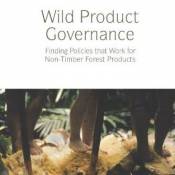Forests are Wild – They Need Effective Governance to tap Their Resources
Editors Sarah Laird, Rebecca McLain, and Rachel P. Wynberg underscore this theme in "Wild Product Governance: Finding Policies that Work for Non-Timber Forest Products." They poke and probe through more than a dozen forests in wealthy and developing nations alike. Their conclusions are always the same. Rules that govern forests must be reworked to make the most of the wealth their wild products offer.

Editors Sarah Laird, Rebecca McLain, and Rachel P. Wynberg underscore this theme in “Wild Product Governance: Finding Policies that Work for Non-Timber Forest Products.” They poke and probe through more than a dozen forests in wealthy and developing nations alike. Their conclusions are always the same. Rules that govern forests must be reworked to make the most of the wealth their wild products offer.
19 January 2010 | From berries to Brazil nuts and oils to herbs, forests provide a wealth of wild products cultivated and sold for their multiple benefits including food, spices and medicines. With an annual global market expected to exceed US$ 11 billion and could surpass three-to-four times this size, these wild products from the forests are now valued enough to have even earned their own acronym, NTFP, short for non-timber forest products.
Yet, when it comes to oversight and protection, insufficient, confusing and, at times, contradictory laws and procedures dominate forestry governance. From Brazil to British Columbia and in nations throughout the world, there is often little to no correlation between local activities and regional land-use planning. Local communities are often excluded when non-timber forest products’ legal and procedural frameworks are developed. Rarely are the key issues when it comes to cultivation of labor relations and immigrant status considered when NTFP frameworks are designed. And few laws and procedures recognize distinctions between subsistence and recreational harvesting or local, commercial and international trade.
The Time is Now
As forests begin to also be valued for their innate ability to absorb the carbon emissions that otherwise lead to global warming, the time has come for non-timber forest products to be studied and effectively regulated. Clearly, this is an indispensible part of a forest management plan.
This is the message of Wild Product Governance: Finding Policies that Work for Non-Timber Forest Products and its editors, Sarah Laird, Rebecca McLain, and Rachel Wynberg. Their book, released in May, provides a much-needed survey that analyzes the legal and economic trends for non-timber forest products markets throughout the world. By focusing on 13 specific regional studies that span the globe, the book provides project developers, project owners, and communities a resource to analyze legal and economic trends.
Chaos in Washington State
The editors point to NTFP’s oversight in Washington State in the United States as an example of the kind of chaotic, overlapping and insufficient permitting structure that inevitably results in chaos. Here NTFP harvesters working on state and federal lands need entirely different sets of permits to transport, harvest, and sell their wares. Worse still, permitting is rarely enforced. As a result, forests that once offered local residents an opportunity to gather and sell floral greens to feed an $8 billion U.S. market now facilitate theft on private property by persons working without legal status, the editors say.
Launching into Carbon Sinks
Issues and trends are summarized in the books’ final chapters. Here the reader can begin to link community forest carbon trends with microfinance; NTFPs can be viewed as tools that provide alternative income generation opportunities that can facilitate community forestry forest carbon projects sustainability
Wild Product Governance provides a much-needed launching pad for the analyses of forest products and their potential. Those involved in carbon markets should evaluate distinctions between various NTFP alternative-income-generation opportunities when considering the potential of community forest carbon projects. They could benefit by a sequel to this book that includes further study, analysis, and measured action of NTFP harvesting practices and reflects the reality of climate change and how this impacts forest-dependent and forest-intersected communities.
Please see our Reprint Guidelines for details on republishing our articles.

